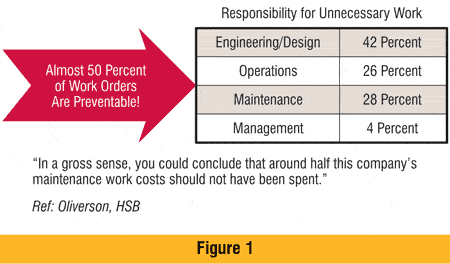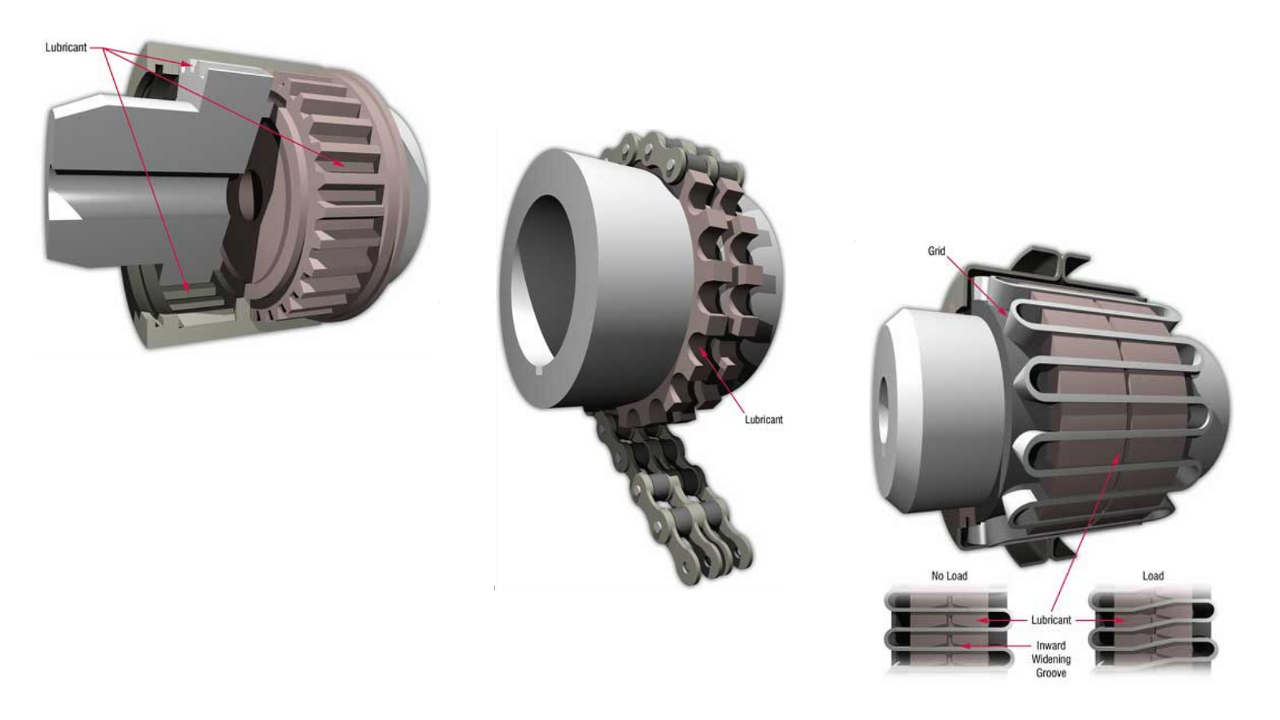Optimizing Lube PMs
Drew Troyer, Noria Corporation
Grease a bearing, change the oil, decontaminate a system, change a filter . . . why do we perform these tasks, commonly called preventive maintenance or lube PMs and what drives the frequency with which they are performed? Sadly, few maintenance managers can truly answer these questions. When selected correctly, lube PMs are performed with intention . . . there is a belief that a causal relationship exists between the performance of the task and some desirable result, such as improved reliability and/or reduced maintenance cost. Regrettably, lube PMs are often selected, scheduled and carried out with little thought regarding this critical relationship, or ineffective lube PMs are perpetuated simply because that is the easiest path. As a result, resources employed to complete lube PMs are often wasted (Figure 1).

In my consulting experience, when a manager or engineer is asked why a lubrication PM is performed at a particular interval or in a particular way, the answer is usually “I don’t know, “the OEM manual says to do it that way” or the universal “we have always done it that way.” In today’s global market, these answers aren’t good enough. Today’s industry requires precision reliability and maximized return on net assets (RONA), which in turn demands precision maintenance, including lubrication. The low cost producer in a given market segment will not have the luxury to carry out lubrication PMs in the casual manner in which they been performed in the past. They must be optimized with respect to cost and benefit.
A number of common mistakes are made in selecting, scoping and carrying out lubrication PM tasks and intervals. I have outlined four common “wrongs” with respect to lube PM optimization, which can, with some effort and guidance, be turned into four “rights.”
Wrong Task
Sometimes, the required task is not included in the lube PM program. For example, routine inspections often don’t include all the parameters that they should, a machine is not on an oil analysis program, but should be or a machine’s lubricant should be periodically decontaminated but it is not. In other cases, lube PMs are in the system that shouldn’t be. For example, scheduled tasks that should be replaced with condition-based tasks, or tasks that have been piled onto a machine in response to a failure for which no clear understanding about why the failure occurred was established.
We want to perform the right lube PM tasks . . . those that eliminate, or reduce the likelihood of potential failures. Task selection should be driven by the inductive failure modes, effects and criticality analysis (FMECA) and deductive failure root cause analysis (RCA). Where RCA is used to add or eliminate a lube PM tasks, be sure a clear cause-effect relationship exists. Confirm that retained tasks do indeed produce the desired result.
Wrong Interval
Sometimes, the interval between scheduled tasks is too long, which leaves machines running dry, or operating with degraded or contaminated lubricant. In other cases, the interval is too short, which can lead to seal damage and a loss of contaminant exclusion effectiveness, friction and heat generation, leaks, spills and overflow, and wasted materials and labor.
When defining a lube PM task interval, start with any available OEM recommendations, but consider the operating environment and application in the decision. In some cases, OEM manuals don’t spell out lube PM tasks in sufficient detail, or the manuals are grossly outdated. In these cases it is necessary to calculate lube PM task intervals using available formulas and so-called “wizards,” employ measurements to empirically verify the validity of the task interval, or use some combination of formulas and empirical verification. Like task selection, the lube PM task interval should be driven by FMECA and RCA.
Wrong Design or Technology
We routinely see lube PM tasks that can’t be performed due to lack of access. Either the machine’s design physically excludes access to the lube point, accessing the lube point would create a safety risk for the lube tech or completion of the task requires the machine to be shutdown or slowed down.
When purchasing a machine, one may choose to minimize the acquisition cost, or to minimize the life cycle cost. The life cycle cost is the present value of all costs associated with asset ownership, including acquisition, operation, maintenance and disposition. Maintainability (for example, correct lubrication system, accessibility for relubrication) is often compromised when the acquisition cost minimization-based purchase process is employed. Consider lubrication maintainability carefully when purchasing a new piece of equipment.
In other cases, the application is made tougher (such as extended periods between scheduled outages), the environment has changed, it was impossible to foresee application and environmental challenges during the design phase, or technology has changed. In these instances, it is necessary to modify the machine to optimize the lubrication system, which includes lube delivery, contamination control, inspections, sampling, etc., to reflect the true needs of the equipment. Again, the design and/or modification process should be driven by FMECA and RCA.
Wrong Procedure
Often, the lube PM task and interval are selected properly, and the technology and design are correct, but the task is not completed properly. This is because the procedure is nonexistent, wrong, unclear and/or hard to follow, unavailable or difficult to access, not trained or not enforced. The procedure is the manifestation of a well-engineered machinery lubrication program. Once lube PM tasks are selected, the interval is optimized and any design or technology modifications are completed, it is necessary to create, implement, train and enforce procedures that ensure that the intended task is completed in a way that delivers the intended result.
The entire lubrication PM program, once it is optimized, must be periodically revisited to ensure that it achieves its intended objectives. Technology changes, the application changes, management’s objectives change and the operating environment change; a periodic review and update of your lube PM program is a must. Think of it as preventive maintenance for your lube PM program.
The entire idea of optimizing lubrication PMs may seem daunting. However, it is not in the best interest of the organization to dedicate such a large portion of the maintenance budget to a lube PM program that fails to deliver the desired level reliability and low cost of ownership. Ben Franklin once said “an ounce of prevention is worth a pound of cure.” His quote summarizes the reasoning behind developing a lube PM program in the first place. It seems appropriate to apply this same logic to the design, deployment and management of the lube PM program itself.
This discussion is not intended to serve as a technical foundation from which to reinvent your lubrication PM program. Rather, it is intended to provoke thought and discussion. Look for a detailed article, or series of articles, on developing and managing an effective lubrication PM program in future issues of Machinery Lubrication magazine.
This is my viewpoint. As always, I’m interested in yours.
“Ultimately, human intentionality is the most powerful evolutionary force on this planet.” -George Leonard
Drew Troyer, “Optimizing Lube PMs”. Machinery Lubrication Magazine. September 2002
Related Articles

The Lubrication Requirements of Couplings

The Building Blocks to Creating an Effective Lubrication Program

Does Lubrication Belong in the CMMS?

Water Contamination

Ultrasound for Better Lubrication

Top Ten Ways Not to be World Class at Machinery Lubrication





